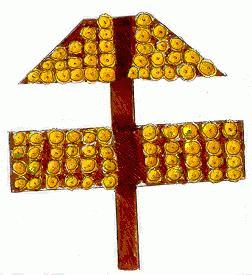
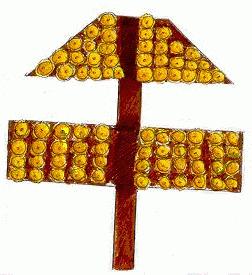
 |
Examples |  |
~~~~~~~~~~~~~~~~~~~~~~~~~~~~~~~~~~~~~~~~~~~~~~~~~~~~~~~~~~~~~~~~~~~~~~~~~~~~~~~~
|
|
~~~~~~~~~~~~~~~~~~~~~~~~~~~~~~~~~~~~~~~~~~~~~~~~~~~~~~~~~~~~~~~~~~~~~~~~~~~~~~~~~~~~~~~~~~~~~~~~~~~~~~~~
This is Larry .....

|
.. and this is his mate Sheila ..

|
....... and this is Wacker who plays with them both.
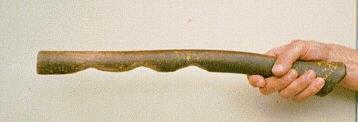
... and they all belong to the Bushwahzee Band who visit schools to show you how to do bush dancing. So if you ask they might come to your school and perform for you. Perhaps even do their own lagerphone song in which you can join.
~~~~~~~~~~~~~~~~~~~~~~~~~~~~~~~~~~~~~~~~~~~ Some technical notes on Larry : A tea-tree bough, four feet high with a fork in the top to serve as a handle. Four columns of crown seals in eleven rows. The tops were obtained pre-insertion and are screwed in with two tops per screw and a small washer on the outer end. The screw heads are 1" proud from the post and the rubber foot came from a crutch. Felix of the Bushwazhee describes Larry as 'very much a working lagerphone'.
Sheila : - of course - is a mop turned upside down. A bit shorter than Larry and again with two tops per screw but no washers and only two columns (to make her lighter) of fifteen rows.
|
|
| And the Wacker : ... is an axe handle cut into three notches each approximately half a handle deep and 3" apart from dip to dip. The ridge between each is about 1" wide to avoid chipping. |
|||
~~~~~~~~~~~~~~~~~~~~~~~~~~~~~~~~~~~~~~~~~~~~~~~~~~~~~~~~~~~~~~~~~~~~~~~~~~~~~~~~~~~~~~~~~~~~~~~~~~~~~~~~~~
|
Now here is a variation on a theme. When you first make a lagerphone with a crossboard you will probably fasten the bottle tops on in some sort of geometrical pattern, but if you are good at design work you may prefer a more artistic pattern. You can, of course, have circles and squares and anything you like, and an outline map of Australia is popular. This example is from the Canberra band Franklyn B. Paverty who have spelled out their name on the front using studs and then used the reverse for bottle tops. There are two tops per nail with no washers but they stand 1" proud so that a forward and backward movement produces a swishing noise. Note the flare at the top of the post - that is because it is a hoe handle.
|
 |
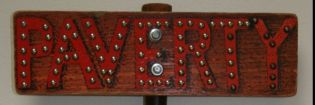 |
|
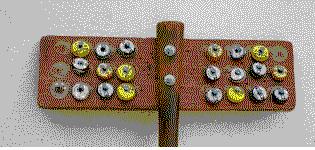 |
|||
|
The board itself it held on by two coach bolts. Graham Chalker, the Paverty lagophonist, drills holes into the wood and then hammers the bolts in. That may sound like putting a square bolt in a round hole, but he assures me it works well. On the foot of the pole is a doorstop held on with a hose clamp. The white section below the board is masking tape. The lagerphone itself is some twenty years old and the middle section got worn out - the durability point again - and Graham first tried filling with putty but that did not last so he changed to the masking tape. Height is about five feet and width sixteen inches.
|
|||
~~~~~~~~~~~~~~~~~~~~~~~~~~~~~~~~~~~~~~~~~~~~~~~~~~~~~~~~~~~~~~~~~~~~~~~~~~~~~~~~~~~~~~~~~~~~~~~~~~~~
| And now another variation - a lagerphone designed to go with the band's name - the Southern Cross band from Sydney - with whose lagophonist, Tony Romeo, I met up with during a marvelous week of bush dancing on Norfolk Island in April 2008. The five stars are in the pattern of the (Australian) Southern Cross and then the spaces between are filled with the usual crown seals. Those are screwed in with two tops per screw all with the base outwards and three metal discs to hold them in. The pole is a mallet handle and the overall weight makes it the heaviest lagerphone I have handled - but Tony in action, bouncing it high, is a sight to be seen. |  |
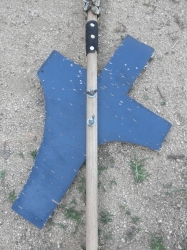 |
|||
| In May 2024, Tony Romeo posted a series of 7 videos that cover the lagerphone's history, construction and playing. The series also contains examples and annotations for learning beat patterns that can be applied to a whole range of musical tempos, as well as providing practical tips and suggestions for accompanying songs and dance music and generally getting the best sound out of your lagerphone. The videos range from 5 - 10mins long and they are well worth a look! | |||||
~~~~~~~~~~~~~~~~~~~~~~~~~~~~~~~~~~~~~~~~~~~~~~~~~~~~~~~~~~~~~~~~~~~~~~~~~~~~~~~~~~~~~~~~~~~~~~~~~~~~~~~~~~~~
|
I use a particularly tall lagerphone - partly because it matches my height - 6'4" or nearly two metres - and partly because at the childrens' dances I go out on the dance floor dressed as a bushie - hat with corks, etc - and dance around in and out among the children themselves. The more noise I can make obviously the greater the impression. Indeed so much of a distraction can I be that I do not go out until Diana has led them through one full cycle. Partly because it is so large I have designed it as separate pieces held together with bolts and wing nuts. The pole is 1" square and nearly my height. In the top section are a series of six holes onto which the boards bolt. Both boards are 6" deep, the upper being a trapezoid (6" across the top, 17" across the bottom) and the lower a rectangle (17" wide). The upper board always goes onto the two uppermost holes but the lower can go onto any two adjacent lower holes. It thus gets three possible positions which can be chosen to
suit anyone less tall than me. (But if it comes down to the lowermost pair of holes then, of course, it ceases to be a lagerphone and becomes a smallerphone.) It can also be dismantled for transporting.
|

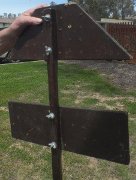 |
 |
Another from my collection and the one I am currently using most because it is easier to pick up and play than is the the one to the left. I have a friend Peter Hogan (no, no relation so far as he knows) who has a bush block at Beavandale to the west of Goulburn in New South Wales. I was visiting one day and mentioned that I was looking for some rustic timber from which to fashion lagerphones. So we set off with a bush saw and came back dragging various boughs which I pushed into the back of my Holden panel van and brought back to Canberra. For some time I had them parked on my back patio where they were easily visible from my kitchen and gradually developed ideas about what to do with them. This was one result. I trimmed various subsidiary branches - you can see the stump of one low down just above the third pair of bottle tops - but left one higher up to make a cleft through which I can stroke the scraper stick. Another small one at the top I left because it makes a convenient thumb rest.
|
~~~~~~~~~~~~~~~~~~~~~~~~~~~~~~~~~~~~~~~~~~~~~~~~~~~~~~~~~~~~~~~~~~~~~~~~~~~~~~~~~~~~~~~~~~~~~~~~~~~~~~~~~~~~~~~~~~
|
Lagerphones can be awkward things to carry around and I have now met three lagophonists who have solved the transport problem by cutting the pole into two pieces and then rejoining them with a metal sheath.
|
 |
And for all those with some of the Irish in their blood - this example comes to me from Leonie Dettmann in Queensland |  |
||||
| One was Noel Harrington whom I met at Major's Creek and who strapped the two sections to the side of his motorbike and set off in pursuit of his band. The second is Paul Duncan of the now demised Ants Bush Band from the Mornington Peninsula who has sent me the adjoining pictures. He tells me that his 'rattling road sign' is 168cm in height, 40 in width, and that with 183 genuine CUB bottle tops attached weighs 3.5kg. (And that has started me wondering about lagerphone weights in general - which may of course explain the dearth of female lagophonists). | 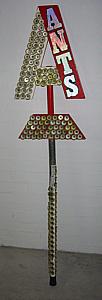 |
||||||
|
|||||||
|
The third is Walter Bollinger of the (Sydney) Ryebuck Bush Band. "The original intention was that it could be taken apart and reassembled in a similar manner to a tent pole. The shaft is a hoe handle, inverted with a tube of aluminium over the join. At each end of the tube there is a bolt going through the tube and shaft and then secured by a nut. [However] I have never taken the lagerphone apart for travelling as I found that the tube gets deformed from being bashed, preventing the shaft from being slid out from inside it. After a period of time the aluminium tube wears through and then requires replacing. I use a striker with upholstery studs on it as it works better with metal on metal." {And it certainly sounds clearly across a dance floor! - KMS}
|
~~~~~~~~~~~~~~~~~~~~~~~~~~~~~~~~~~~~~~~~~~~~~~~~~~~~~~~~~~~~~~~~~~~~~~~~~~~~~~~~
|
Lagophonists are nothing if not creative so when I crossed tracks with Rick Saur in the Kangaroo Valley I was only moderately startled to learn that he had a pedal operated lagerphone. After suitable obeisances he sent me this excellent picture and the following notation:
"....square posts on a frame with one drive pin and spring loaded for quick rhythms. Not much rattle but if you have both hands full with a drum why not put your feet to work? Holds about 400 bottle tops. Can fit more but it takes too long to get that flamin' plastic out. Timber is a combination of maple and ironbark, anything else was waibomen timber. The rest is a trade secret."
But maybe with a few more obeisances I might get a complementary picture from the opposite side?
|
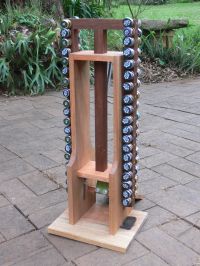 |
~~~~~~~~~~~~~~~~~~~~~~~~~~~~~~~~~~~~~~~~~~~~~~~~~~~~~~~~~~~~~~~~~~~~~~~~~~~~~~~~~~~~~~~~~~~~~~~~~~~~~~~~~
|
Now an idea the credit for which goes to Brian Freeman in Sydney - and I am surprised that (apparently) no-one has thought of before - a boomerang suitably adorned and mounted on top of a pole. This is only one of several creative designs of which Brian has sent me pictures - I am encouraging him to set up his own web page to display them.
The detail below shows the block in the middle - using black, red and yellow bottle tops to replicate the aboriginal flag.
 |
 |
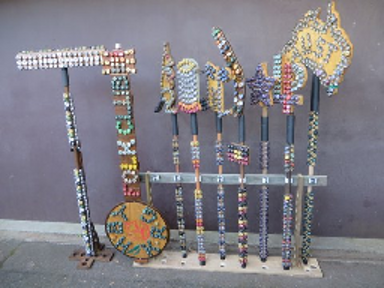 And a whole rackful of Brian's creations. |
~~~~~~~~~~~~~~~~~~~~~~~~~~~~~~~~~~~~~~~~~~~~~~~~~~~~~~~~~~~~~~~~~~~~~~~~~~~~~~~~~~~~~~~~~~~~~~~~~~~~~~~~~~~~~~~~~~~
 | An example of an outline of Australia which has come to me indirectly so I regret I do not know to whom to give the credit. | And Bob Bolton spotted this fellow gracing Franklins Supermarket in Leichhardt, Sydney. |  |
~~~~~~~~~~~~~~~~~~~~~~~~~~~~~~~~~~~~~~~~~~~~~~~~~~~~~~~~~~~~~~~~~~~~~~~~~~~~~~~~~~~~~~~~~~~~~~~~~~~~~~~~~~~~~~~~~~~
| And now something which I am sure will astonish and delight you as much as it has astonished and delighted me. Jazmina Cininas, a professional artist from Melbourne - and I am sure she deserves a much more eminent title than just that - has created a whole roomful of artistic lagerphones which have to be seen to be believed. Here is one just as a taster. |
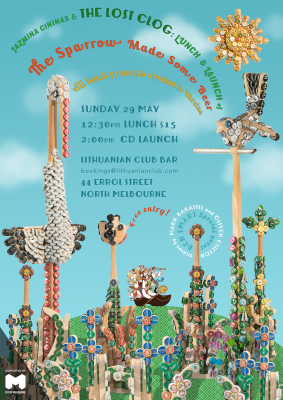
|
~~~~~~~~~~~~~~~~~~~~~~~~~~~~~~~~~~~~~~~~~~~~~~~~~~~~~~~~~~~~~~~~~~~~~~~~~~~~~~~~~~~~~~~~~~~~~~~~~~~~~~~~~~~~~~~~~~~
 |
 |
 |
 |

|